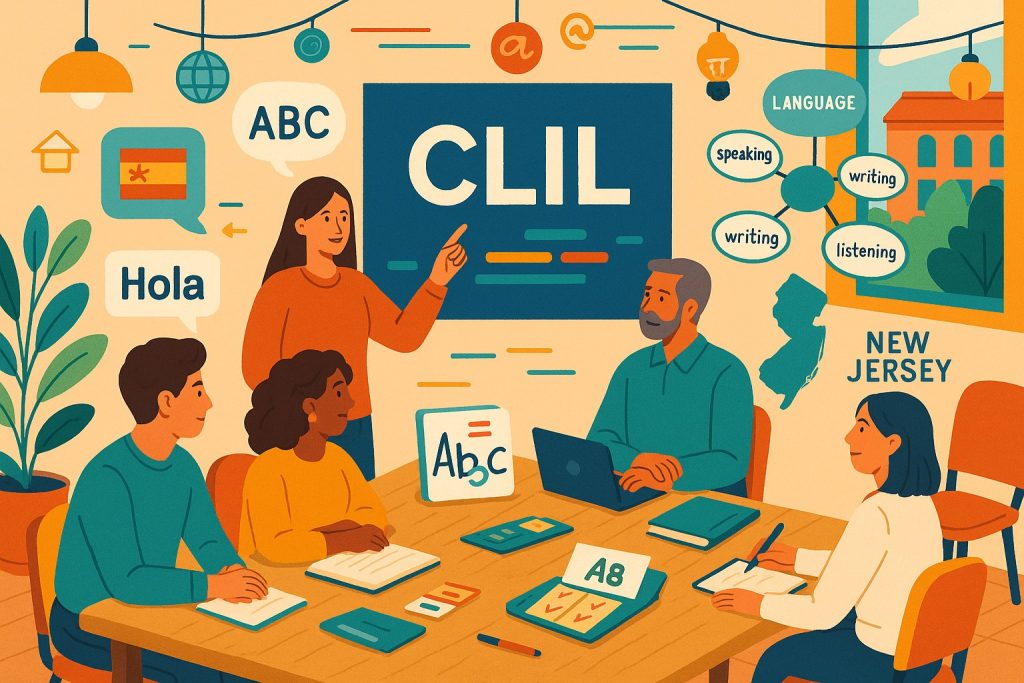
CLIL has gained growing attention in recent years — and for good reason. It’s not just another trendy method for teaching foreign languages; it’s a meaningful mindset that connects subject learning and language skills in one flow. What makes CLIL truly work is the way it keeps both the mind and the language muscles active. Instead of memorizing dry rules or isolated word lists, students actually use the language to understand real ideas — and that makes learning stick in the long run.
Think about it: in a traditional language class, students often spend hours on abstract grammar drills or vocabulary they may soon forget. But when you place that same language inside topics they find interesting — like science, art, or global issues — it suddenly becomes something they want to talk about. Imagine a student learning about volcanoes or renewable energy in English. They don’t just repeat new words; they describe, compare, and explain, using the language in a real context. This kind of learning naturally promotes better memory and deeper understanding because it’s connected to something meaningful.
CLIL also gives the brain a proper workout. Students process information on two levels at once: they’re trying to grasp the subject content while decoding it in a new language. This mental effort builds focus, reasoning, memory, and problem-solving skills. Research shows that students in CLIL environments often do better in analytical tasks because they’re used to handling complex ideas in a second language. And while they’re doing all this, they also develop a stronger sense of how language works. Many learners start noticing grammar patterns and academic vocabulary in a more conscious way, which boosts their awareness of their native language, too.
What’s really powerful about CLIL is how it breaks down the walls between “content” and “communication.” In the real world, we don’t separate what we know from how we express it. CLIL does the same: students might discuss a historical event, describe a science experiment, or debate a current issue — all through the target language. This gives them plenty of practice with cognitive-linguistic tasks like describing, comparing, and classifying, which are so important for academic success.
And let’s not forget motivation. Students see firsthand that knowing a foreign language is not just an abstract goal; it’s a practical tool. They realise that learning English, for example, helps them understand a documentary, present a geography project, or join an international conversation. This sense of purpose makes them more willing to participate, to make mistakes, to keep trying — which is exactly what language learning needs.
In the end, CLIL works because it brings content and language together in a way that makes sense. It challenges students intellectually, helps them grow socially and linguistically, and turns the classroom into a space where knowledge is not just delivered but explored and constructed together. That’s the kind of learning that stays with you long after you’ve left the classroom.
Dr. Humeyra Turedi
References
- Coyle, D., Hood, P., & Marsh, D. (2010). CLIL: Content and Language Integrated Learning. Cambridge University Press.
- Dalton-Puffer, C. (2011). Content-and-language integrated learning: From practice to principles? Annual Review of Applied Linguistics, 31, 182–204.
- Genesee, F. (1994). Integrating language and content: Lessons from immersion. Educational Practice Reports, Center for Applied Linguistics.
You can read the Turkish version of the article below.
Neden CLIL : Bütünleşik Öğrenmenin Bilişsel ve Akademik Avantajları
CLIL son yıllarda giderek daha fazla ilgi görüyor — ve bu da boşuna değil. Bu, sadece başka bir popüler yabancı dil öğretim yöntemi değil; konu öğrenimi ile dil becerilerini tek bir akışta birleştiren anlamlı bir zihniyettir. CLIL’in gerçekten işe yaramasını sağlayan şey, hem zihni hem de dil kaslarını aktif tutmasıdır. Öğrenciler kuru kurallar ezberlemek ya da yalıtılmış kelime listeleriyle uğraşmak yerine, dili gerçek fikirleri anlamak için kullanırlar — ve bu da öğrenmeyi uzun vadede kalıcı kılar.
Şöyle düşünün: Geleneksel bir dil sınıfında öğrenciler çoğu zaman soyut dilbilgisi alıştırmalarına ya da kısa sürede unutabilecekleri kelimelere saatlerini harcar. Oysa aynı dili, onların ilgisini çeken konuların içine yerleştirdiğinizde — örneğin fen bilgisi, sanat ya da küresel sorunlar — bir anda hakkında konuşmak istedikleri bir şeye dönüşür. Bir öğrencinin İngilizce olarak volkanlar ya da yenilenebilir enerji hakkında bilgi edinmeye çalıştığını hayal edin. Yeni kelimeleri sadece tekrar etmekle kalmaz; betimler, karşılaştırır, açıklar — dili gerçek bir bağlamda kullanır. Bu tür öğrenme, hem hafızayı geliştirir hem de daha derin bir kavrayış sağlar çünkü öğrendikleri şey bir anlamla bağlantılıdır.
CLIL aynı zamanda beyne gerçek bir antrenman sağlar. Öğrenciler aynı anda iki düzeyde bilgi işlerler: hem konuyu anlamaya hem de bunu yeni bir dilde çözümlemeye çalışırlar. Bu zihinsel çaba, odaklanmayı, akıl yürütmeyi, hafızayı ve problem çözme becerilerini geliştirir. Araştırmalar, CLIL ortamlarında eğitim alan öğrencilerin, karmaşık fikirleri ikinci bir dilde işlemeye alışkın oldukları için analitik görevlerde daha başarılı olduklarını gösteriyor. Tüm bunları yaparken, aynı zamanda dilin nasıl işlediğine dair daha güçlü bir farkındalık da geliştirirler. Birçok öğrenci, dilbilgisi kalıplarını ve akademik kelime dağarcığını daha bilinçli şekilde fark etmeye başlar; bu da kendi ana dillerine olan farkındalıklarını da artırır.
CLIL’in en güçlü yanlarından biri de “içerik” ve “iletişim” arasındaki duvarları yıkmasıdır. Gerçek dünyada, ne bildiğimizi nasıl ifade ettiğimizden ayırmayız. CLIL de bunu yapar: Öğrenciler tarihi bir olayı tartışabilir, bir fen deneyini betimleyebilir ya da güncel bir mesele üzerine fikir yürütebilir — tüm bunları hedef dil aracılığıyla gerçekleştirirler. Bu da onlara betimleme, karşılaştırma ve sınıflandırma gibi bilişsel-dilsel görevler konusunda bolca pratik yapma fırsatı sunar; ki bu görevler akademik başarı için çok önemlidir.
Bir de motivasyon var. Öğrenciler bir yabancı dil bilmenin soyut bir hedef olmadığını, pratik bir araç olduğunu ilk elden görürler. Örneğin, İngilizce öğrenmenin onlara bir belgeseli anlamada, bir coğrafya projesi sunmada ya da uluslararası bir tartışmaya katılmada yardımcı olduğunu fark ederler. Bu amaç duygusu, onları daha istekli yapar: katılmaya, hata yapmaya ve denemeye açık hale getirir — ki bu da dil öğreniminin tam olarak ihtiyaç duyduğu şeydir.
Sonuç olarak CLIL, içerik ve dili anlamlı bir biçimde bir araya getirdiği için işe yarar. Öğrencilere entelektüel bir meydan okuma sunar, onları hem sosyal hem de dilsel olarak geliştirir ve sınıfı sadece bilginin aktarıldığı değil, birlikte keşfedilip inşa edildiği bir mekâna dönüştürür. İşte bu tür bir öğrenme, sınıftan çıktıktan sonra da sizinle kalır.
Kaynakça
Coyle, D., Hood, P., & Marsh, D. (2010). CLIL: Content and Language Integrated Learning. Cambridge University Press.
Dalton-Puffer, C. (2011). Content-and-language integrated learning: From practice to principles? Annual Review of Applied Linguistics, 31, 182–204.
Genesee, F. (1994). Integrating language and content: Lessons from immersion. Educational Practice Reports, Center for Applied Linguistics.
Dr. Hümeyra Türedi



